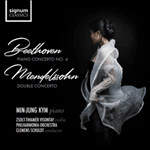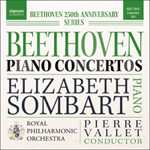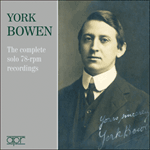
Welcome to Hyperion Records, a British classical label devoted to presenting high-quality recordings of music of all styles and from all periods from the twelfth century to the twenty-first.
Hyperion offers both CDs, and downloads in a number of formats. The site is also available in several languages.
Please use the dropdown buttons to set your preferred options, or use the checkbox to accept the defaults.

 PERFORMANCE
PERFORMANCE RECORDING
RECORDING

Most unusually, the concerto begins with solo piano, with the opening phrase then answered by the orchestra. The rest of the movement is in the standard first-movement form, but the start signals that the relationship between soloist and orchestra will be unusually close. The second movement takes up this idea, with angry unison outbursts from the orchestra answered by gentle chords in the piano, with soft pedal (the first time Beethoven had indicated this). Gradually the anger of the orchestra is placated, and the movement ends peacefully. Some writers have suggested it is a portrayal of Orpheus taming the wild beasts or the Furies, but the music is not so specific. It represents any situation where anger is gradually abated through placid responses. In the finale, trumpets and drums are heard for the first time, as if celebrating the piano’s victory over the orchestra in the previous movement. The finale actually begins out of key, in C major, to suit the trumpets and drums, but it works its way convincingly to the home key before the end, passing through several others on the way.
from notes by Barry Cooper © 2020
Exceptionnellement, ce concerto commence par le piano seul, l’orchestre répondant ensuite à la première phrase. Le reste du mouvement s’inscrit dans la forme standard de premier mouvement, mais le début montre que le soliste et l’orchestre entretiendront des relations d’une inhabituelle proximité. Le deuxième mouvement reprend cette idée, avec des éclats de colère de l’orchestre à l’unisson auquel le piano répond par de doux accords, avec la pédale douce (la première fois que Beethoven l’indique). Peu à peu, la colère de l’orchestre s’apaise et le mouvement s’achève paisiblement. Certains auteurs ont suggéré qu’il s’agirait d’un portrait d’Orphée domptant les bêtes sauvages ou les Furies, mais la musique n’est pas aussi précise. Elle correspond à toute sorte de situation où la colère diminue peu à peu par le biais de réponses placides. Dans le finale, les trompettes et les timbales se font entendre pour la première fois, comme si elles célébraient la victoire du piano sur l’orchestre dans le mouvement précédent. Le finale commence en réalité hors de la tonalité, en ut majeur, pour convenir aux trompettes et aux timbales, mais il se dirige avec conviction vers la tonalité d’origine qu’il atteint avant la fin, en passant en chemin par plusieurs autres tonalités.
extrait des notes rédigées par Barry Cooper © 2020
Français: Marie-Stella Pâris
Außergewöhnlich ist der Anfang für das Klavier allein, dessen Phrase dann vom Orchester beantwortet wird. Im Übrigen steht der Satz in der gleichen Form, wie sie bereits für das erste Klavierkonzert; der Beginn jedoch zeigt an, dass das Verhältnis von Solo und Tutti hier ungewöhnlich eng ist. Der zweite Satz greift diesen Gedanken auf: Die schroffen Gesten des Orchesters beantwortet das Klavier mit zarten Akkorden, zu spielen mit Pianopedal, wie Beethoven hier erstmals vorschreibt. Der Zorn des Orchesters wird nach und nach beschwichtigt, und der Satz endet ruhig. Manche Autoren meinen, es handele sich um eine Darstellung des Orpheus, der wilde Tiere oder Furien beruhige; doch gibt die Musik das so genau nicht her. Sie steht für jede Situation, in der Wut durch sanfte Gegenrede schrittweise besänftigt wird. Im Finale kommen endlich Trompeten und Pauken zum Einsatz, als feierten sie den Sieg des Klaviers über das Orchester im Satz davor. Der Satz beginnt in der „falschen“ Tonart, in C-Dur, das den Pauken und Trompeten mehr liegt. Doch arbeitet er sich in seinem Verlauf, etliche andere Tonarten durchstreifend, überzeugend zur Grundtonart durch.
aus dem Begleittext von Barry Cooper © 2020
Deutsch: Friedrich Sprondel
 Beethoven: Piano Concerto No 4; Mendelssohn: Double Concerto Beethoven: Piano Concerto No 4; Mendelssohn: Double ConcertoSteinway Artist Min-Jung Kym makes her recording debut with Beethoven’s Piano Concerto No 4 and Mendelssohn’s Double Concerto, in which she is joined by violinist and regular duo partner Zsolt-Tihamér Visontay.» More |
 Beethoven: Piano Concertos Nos 3 & 4 Beethoven: Piano Concertos Nos 3 & 4Elizabeth Sombart continues her Beethoven Piano Concertos cycle with the RPO and conductor Pierre Vallet.» More |
 York Bowen - The complete solo 78-rpm recordings York Bowen - The complete solo 78-rpm recordings‘Well filled set and plenty to arrest the imagination’ (MusicWeb International)» More |

